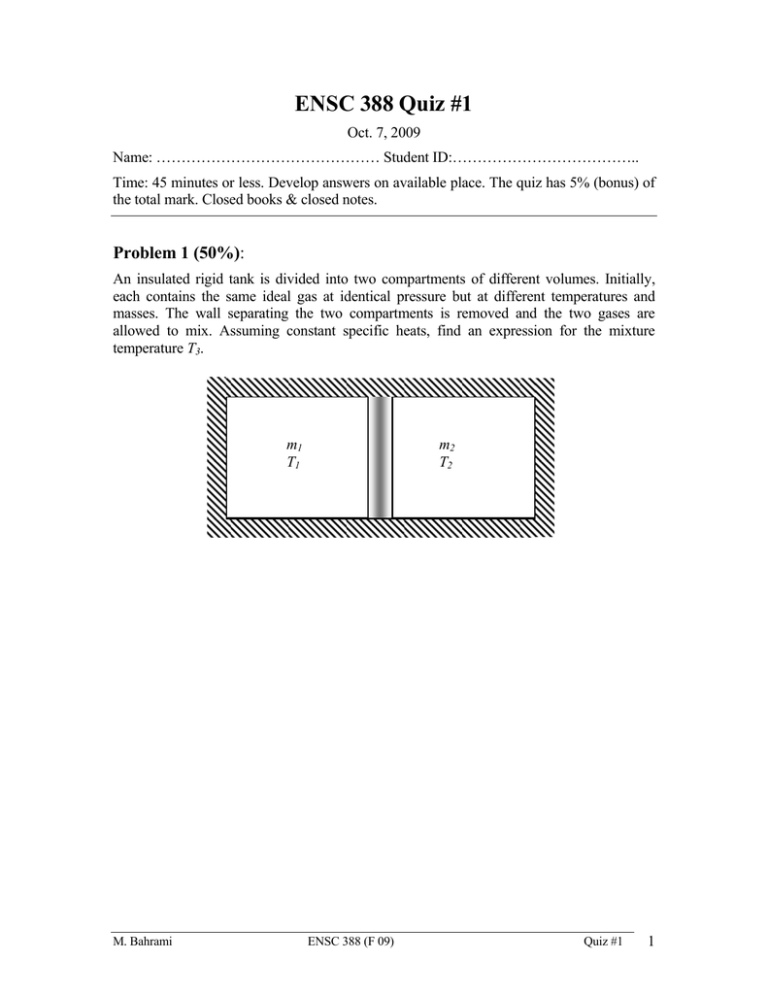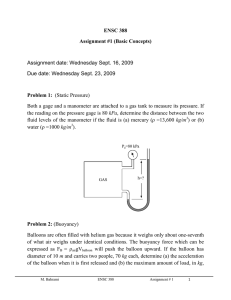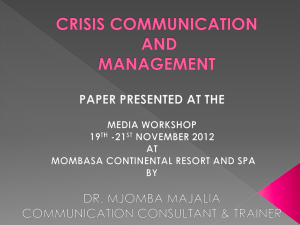ENSC 388 Quiz #1
advertisement

ENSC 388 Quiz #1 Oct. 7, 2009 Name: ……………………………………… Student ID:……………………………….. Time: 45 minutes or less. Develop answers on available place. The quiz has 5% (bonus) of the total mark. Closed books & closed notes. Problem 1 (50%): An insulated rigid tank is divided into two compartments of different volumes. Initially, each contains the same ideal gas at identical pressure but at different temperatures and masses. The wall separating the two compartments is removed and the two gases are allowed to mix. Assuming constant specific heats, find an expression for the mixture temperature T3. m1 T1 M. Bahrami m2 T2 ENSC 388 (F 09) Quiz #1 1 Problem 2 (50%): The air flow in a compressed air line is divided into two equal streams by a T-fitting in the line. The compressed air enters this 2.5 cm = 0.025m diameter fitting at 1.6 MPa and 40◦C with a velocity of 50 m/s. Each outlet has the same diameter as the inlet, and the air at these outlets has a pressure of 1.4 MPa and a temperature of 36◦C. Determine the velocity of the air at the outlets and the rate of change of flow energy (flow power) across the T-fitting. The gas constant of air is R= 0.287( kPa.m3/kg.K) 1.4 MPa 36C 1.6 MPa 40C 50 m/s 1.4 MPa 36C M. Bahrami ENSC 388 (F 09) Quiz #1 2 5-131 5-157 The mass flow rate of a compressed air line is divided into two equal streams by a T-fitting in the line. The velocity of the air at the outlets and the rate of change of flow energy (flow power) across the Tfitting are to be determined. Assumptions 1 Air is an ideal gas with constant specific heats. 2 The flow is steady. 3 Since the outlets are identical, it is presumed that the flow divides evenly between the two. Properties The gas constant of air is R = 0.287 kPam3/kgK (Table A-1). 1.4 MPa 36°C Analysis The specific volumes of air at the inlet and outlets are v1 v2 RT1 P1 v3 (0.287 kPa m 3 /kg K)(40 273 K) 1600 kPa RT2 P2 0.05614 m 3 /kg 3 (0.287 kPa m /kg K)(36 273 K) 1400 kPa 0.06335 m 3 /kg 1.6 MPa 40°C 50 m/s Assuming an even division of the inlet flow rate, the energy balance can be written as A1V1 v1 2 A2V 2 v2 o V 2 V3 A1 v 2 V1 A2 v 1 2 0.06335 50 0.05614 2 1.4 MPa 36°C 28.21 m/s The mass flow rate at the inlet is m 1 A1V1 v1 SD12 V1 4 v1 S (0.025 m)2 4 50 m/s 0.05614 m3/kg 0.4372 kg/s while that at the outlets is m 2 m 3 m 1 2 0.4372 kg/s 2 0.2186 kg/s Substituting the above results into the flow power expression produces Wflow 2m 2 P2v 2 m 1P1v1 2(0.2186 kg/s)(1400 kPa)(0.06335 m3/kg) (0.4372 kg/s)(1600 kPa)(0.05614 m3/kg) 0.496 kW PROPRIETARY MATERIAL. © 2008 The McGraw-Hill Companies, Inc. Limited distribution permitted only to teachers and educators for course preparation. If you are a student using this Manual, you are using it without permission. 4-117 4-155 An insulated rigid tank is divided into two compartments, each compartment containing the same ideal gas at different states. The two gases are allowed to mix. The simplest expression for the mixture temperature in a specified format is to be obtained. Analysis We take the both compartments together as the system. This is a closed system since no mass enters or leaves. The energy balance for this stationary closed system can be expressed as E Eout in Net energy transfer by heat, work, and mass 'Esystem Change in internal, kinetic, potential, etc. energies 0 'U 0 m1cv (T3 T1 ) m2cv (T3 T2 ) (m1 m2 )T3 (since Q = W KE = PE = 0) m1 T1 m2 T2 m1T1 m2T2 and, m3 m1 m 2 Solving for final temperature, we find T3 m m1 T1 2 T2 m3 m3 PROPRIETARY MATERIAL. © 2008 The McGraw-Hill Companies, Inc. Limited distribution permitted only to teachers and educators for course preparation. If you are a student using this Manual, you are using it without permission.





